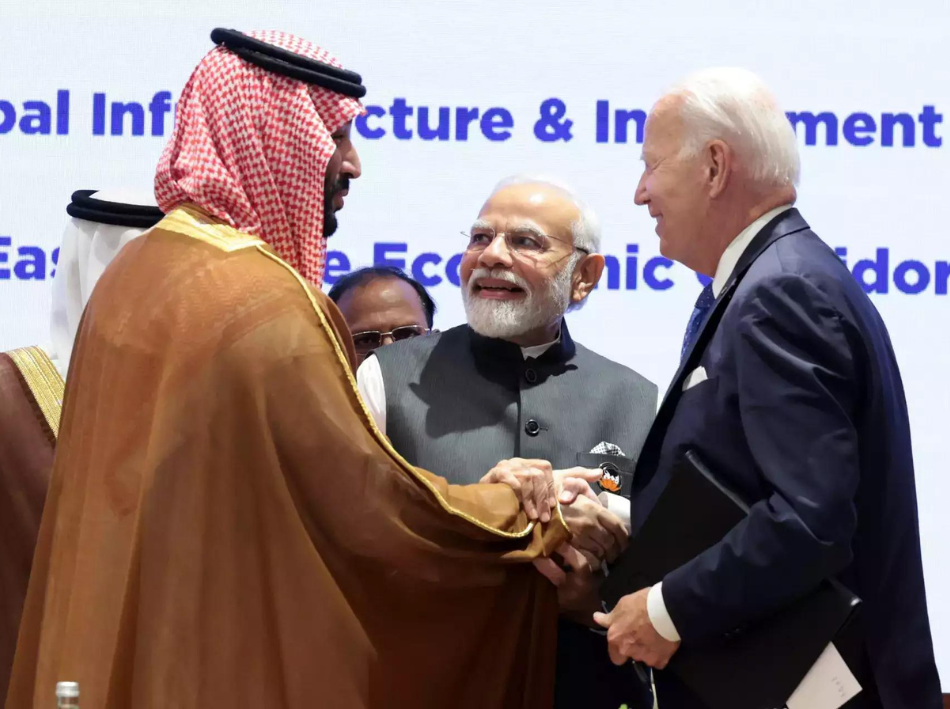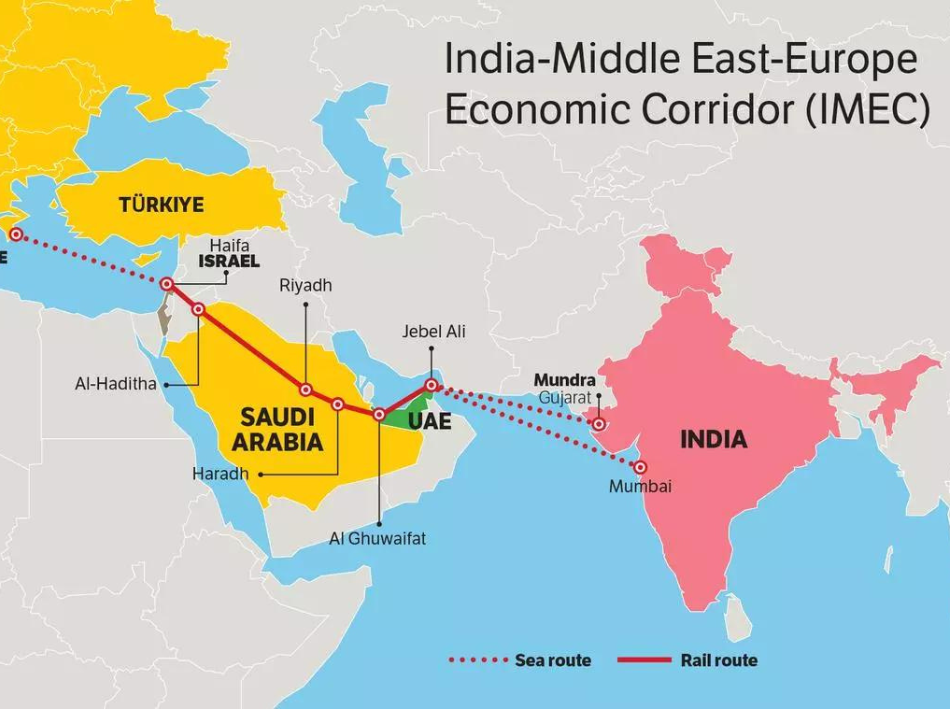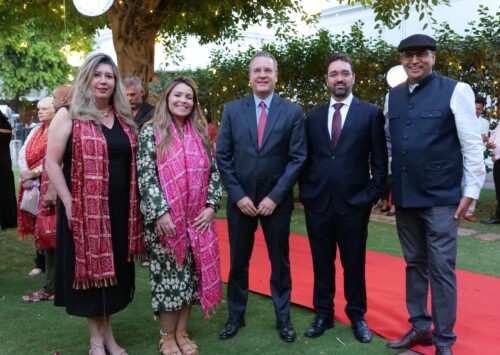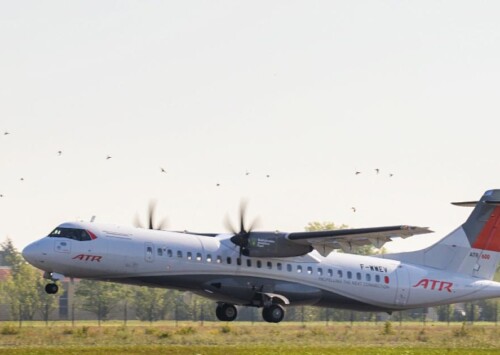IMEC can be cement to bind together fragmented world trade

Prime Minister Narendra Modi, Saudi Crown Prince Mohammed bin Salman Al Saud and United States President Joe Biden
One of the most significant achievements of the Indian Presidency of the G20 was the announcement of the India-Middle East-Europe Economic Corridor (IMEC) during the G20 Summit in New Delhi in September.
In concept and theory, the IMEC is not very different from the Bridges and Roads Initiative (BRI), launched by China exactly a decade ago and which has already led to investments of over USD 1 trillion, almost entirely by Chinese government and companies.
The IMEC envisages a corridor that would facilitate trading between this large geographical zone, home to over 2 billion people, and which will bring all round development in some of the poorest areas of the world.
The IMEC holds a significant potential for enhancing economic integration, trade, investments, and fostering cooperation among the participating countries on multiple fronts. The hosting of G20 Summit and announcement of IMEC have come at a time when global geopolitical landscape is witnessing tectonic transformations that have left the world order shattered and fragmented, as rarely before, and which has clearly been underscored over the past two years by events such as war in Ukraine.
At such a moment, the IMEC can not only provide a healing touch to the world order, but also act as a cement to bind the world back in an organised and unified, though not unitary, democratic and multilateral order.
This ambitious project has the potential to revolutionise global trade dynamics and facilitate international trade by creating a consolidated trade route that will reduce trading costs, promote market access and encourage investment opportunities between the participating countries. What will drive the corridor towards success is the bridging of geopolitical and geoeconomic imbalances between West, Middle East and India.
Indian Prime Minister Narendra Modi declared that this transcontinental corridor will do nothing short of “drive sustainable development for the entire world”. European Commission President Ursula Von der Leyen hailed the ship-to-rail transit network as “a green and digital bridge across continents and civilisations.” In the words of Israeli Prime Minister Benjamin Netanyahu, IMEC will be the “largest cooperation project in our history.”
The countries participating in IMEC constitute 40 pc of the world’s population and roughly 50 pc of the global economy. This corridor will rely on the UAE and Saudi Arabia’s seaports, roads, and logistics hubs, serving to strengthen this Gulf Arab states’ importance as critical nodes in global trade routes. The proposed corridor will enhance economic unity and lower greenhouse gas emissions resulting in a transformative integration of Asia, Europe and the Middle East.
Countering China as BRI in trouble
This year marks the 10th anniversary of China’s Belt and Road Initiative (BRI) since it was launched in 2013, with a claim to improve connectivity and cooperation on a transcontinental scale. After a decade of international cooperation, the BRI has faced significant controversy, primarily related to Beijing’s engagement in exporting corruption, debt-trap diplomacy and exploitation of labour. BRI is unravelling, considering China’s troubled economy and a series of real estate defaults that have occurred there.
For many reasons, the BRI is losing its attractivity amid international concern about China’s long-term objectives. Many countries have begun to understand that the Chinese Communist Party (CCP) aims to control the third world countries through debt incurred due to participation in BRI. In addition, the profits of the BRI projects are getting lower and lower, with the result that there are fewer countries in BRI today.
In 2017, the leaders of 29 countries travelled to Beijing to attend the first Belt and Road Forum, a number that climbed to 37 for the second Belt and Road Forum in 2019. In the third Belt and Road Forum summit held on October 16, only 23 heads of state and government attended. This is a good indicator that enthusiasm for BRI has waned as major projects have run into trouble and countries have less capacity to take on additional debt.
China’s BRI now has a credible challenger. India had refused to join the BRI and had objected to its geographical coverage in the China’s “road map”. Now with IMEC, India has an opportunity to enhance its ties with Middle East countries and deepen its relations. In his 10 years at the helm, Prime Minister Modi has heavily invested his diplomacy and soft power in cultivating good economic and political relations with the Middle East countries, and this has paid off. With its rapid economic growth, India has sought to deepen its trade and strategic relations with the Middle East and has emerged as a major player in the region over the last decade.
As the US had overlooked its geopolitical interest in the Middle East due to its focus on China, the corridor could also serve as America’s diplomatic tool to counter China’s influence in the Middle East. In fact, IMEC should be considered in the same light as Chinese President Xi Jinping’s Belt and Road Initiative. In the light of this, the idea of IMEC fits well because it builds on several diplomatic initiatives that the US and India have pushed forward in the past five years.
But one needs to be cautiously optimistic. Given China’s penetration across developing countries, it is naïve to think that China’s BRI is dead. China will not sit idle and watch its foreign policy objectives go to tatters. It will try new strategy and may shift its programme and policies to keep remain in the market.
This corridor, with strategic and capital from all participating parties, will most certainly offer competition to the Chinese initiative in all respects. With the broad sweep of countries that have offered support to the IMEC, it seems that long-term financial and ecological sustainability, which has been the most serious inadequacies of the BRI, will not pose much of a risk.
Window of opportunities for Western countries
In IMEC, the Western countries, too, have a window of opportunity to come up with a credible infrastructure plan for the developing world. China’s USD 1 trillion Belt and Road Initiative is drowning in bad debts, and the departure of Italy, the only EU member country, from the BRI has sent shock waves in Beijing. Furthermore, the People’s Republic of China has its own financial problems too, meaning it will struggle to pour more money into overseas investments.
The IMEC is grand in vision and ambition, and is the most ambitious multi-national, multi-regional geo-economic and geo strategic project that EU has ever signed. It has potential to deepen physical connectivity, unlock tremendous commercial opportunities, set new standards in infrastructure financing and development, and reshape global trading routes.
The logic of the project goes way beyond the economic case for it as IMEC can show to the world that China’s BRI isn’t the only game in town, as they do have a choice when it comes to their development models. However, it is important that the project becomes economically viable and strategically workable. This will require complete shift in trade and ideological partnership aimed at promoting new generation of trade.
This proposed economic corridor can help Europe restore its historic connection with India and integrate with the wider world at a time when they must look beyond their fossil fuel driven economic strength. In this respect, EU’s Global Gateway and IMEC can become complimentary and supplementary to each other’s objectives.
The IMEC does not only make a great political sense, it also makes a great strategic and economic sense, a geo-political vision of grandeur. In addition, it shall help promote interdependence between participating countries given the state of the affairs in the ME region. However, a lot will depend upon the execution, delivery and participation of the countries associated with the corridor.
A rail bridge between the Mediterranean and the Indo-Pacific should improve access to manufacturing planning a shift out of China, which is the essence of EU’s Indo-Pacific policies and its long-term goal. For India therefore the corridor presents a partly overland trade route that has remained elusive because of political instability in the Northwest. Furthermore, a successful conclusion of India’s free trade negotiations with EU will add flavour to the proposed reconstructed old “spice route”.
High stakes for Gulf States
As United States influence waned in the Middle East due to shift in US policy under Trump administration, China was quick to fill the vacuum with developing economic partnership. Through the IMEC the Biden administration has tried to reassure US allies and partners in the Middle East about Washington’s commitment to the region while also presenting an alternative to China’s Belt and Road Initiative.
The corridor also offers the Gulf Cooperation Council (GCC) an opportunity to work with as many powers as possible, including those which are enemies and rivals of each other. Countries like UAE, Saudi Arabia, and others in the GCC can maximise their geopolitical clout across multiple regions by supporting the project.
Rather than seeing themselves supporting US-led efforts to push back against Beijing’s BRI, the rulers of Emirates and the Saudi Arabia will approach this corridor with the intention of further establishing their countries as bridges between the West, East, and Global South.
To put it simply, IMEC is the latest opportunity for the UAE and Saudi Arabia to become increasingly important hubs of inter-regional connectivity, which will help their plans for more economic diversification away from hydrocarbons.
Middle East is in turmoil and “unpredictability” is the only prediction that one can make. The ongoing violence between Israel and Hamas and what shape this will take in the months and years ahead, no one knows. This new development has underlined the challenges the ambitious initiative to build a new trade route from India through the Middle East to Europe faces. The project involves passing through some of the most volatile regions of the Middle East, the war is a “wake-up” call about the scale of challenges IMEC will have to confront in the future.
Sunil Prasad is the Secretary General of Brussels based Europe India Chamber of Commerce and the views expressed here are his personal views.










